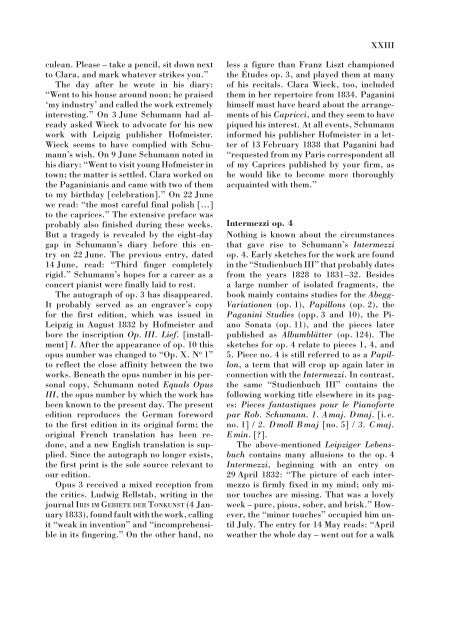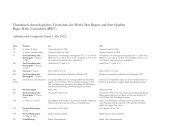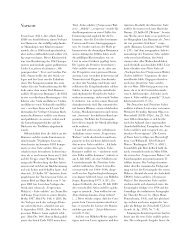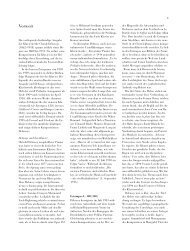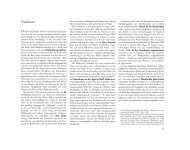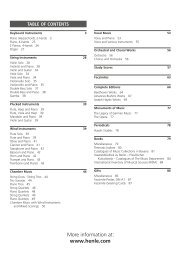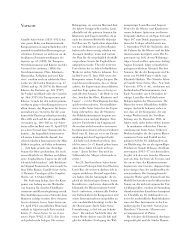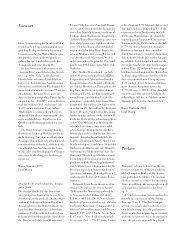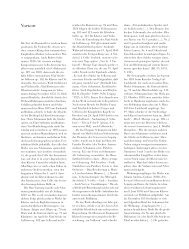Vorwort (PDF, 1698 KB) - Henle Verlag
Vorwort (PDF, 1698 KB) - Henle Verlag
Vorwort (PDF, 1698 KB) - Henle Verlag
You also want an ePaper? Increase the reach of your titles
YUMPU automatically turns print PDFs into web optimized ePapers that Google loves.
XXIII<br />
culean. Please – take a pencil, sit down next<br />
to Clara, and mark whatever strikes you.”<br />
The day after he wrote in his diary:<br />
“Went to his house around noon; he praised<br />
‘my industry’ and called the work extremely<br />
interesting.” On 3 June Schumann had already<br />
asked Wieck to advocate for his new<br />
work with Leipzig publisher Hofmeister.<br />
Wieck seems to have complied with Schumann’s<br />
wish. On 9 June Schumann noted in<br />
his diary: “Went to visit young Hofmeister in<br />
town; the matter is settled. Clara worked on<br />
the Paganinianis and came with two of them<br />
to my birthday [celebration].” On 22 June<br />
we read: “the most careful final polish […]<br />
to the caprices.” The extensive preface was<br />
probably also finished during these weeks.<br />
But a tragedy is revealed by the eight-day<br />
gap in Schumann’s diary before this entry<br />
on 22 June. The previous entry, dated<br />
14 June, read: “Third finger completely<br />
rigid.” Schumann’s hopes for a career as a<br />
concert pianist were finally laid to rest.<br />
The autograph of op. 3 has disappeared.<br />
It probably served as an engraver’s copy<br />
for the first edition, which was issued in<br />
Leipzig in August 1832 by Hofmeister and<br />
bore the inscription Op. III. Lief. [installment]<br />
I. After the appearance of op. 10 this<br />
opus number was changed to “Op. X. N o 1”<br />
to reflect the close affinity between the two<br />
works. Beneath the opus number in his personal<br />
copy, Schumann noted Equals Opus<br />
III, the opus number by which the work has<br />
been known to the present day. The present<br />
edition reproduces the German foreword<br />
to the first edition in its original form; the<br />
original French translation has been redone,<br />
and a new English translation is supplied.<br />
Since the autograph no longer exists,<br />
the first print is the sole source relevant to<br />
our edition.<br />
Opus 3 received a mixed reception from<br />
the critics. Ludwig Rellstab, writing in the<br />
journal IRIS IM GEBIETE DER TONKUNST (4 January<br />
1833), found fault with the work, calling<br />
it “weak in invention” and “incomprehensible<br />
in its fingering.” On the other hand, no<br />
less a figure than Franz Liszt championed<br />
the Études op. 3, and played them at many<br />
of his recitals. Clara Wieck, too, included<br />
them in her repertoire from 1834. Paganini<br />
himself must have heard about the arrangements<br />
of his Capricci, and they seem to have<br />
piqued his interest. At all events, Schumann<br />
informed his publisher Hofmeister in a letter<br />
of 13 February 1838 that Paganini had<br />
“requested from my Paris correspondent all<br />
of my Caprices published by your firm, as<br />
he would like to become more thoroughly<br />
acquainted with them.”<br />
Intermezzi op. 4<br />
Nothing is known about the circumstances<br />
that gave rise to Schumann’s Intermezzi<br />
op. 4. Early sketches for the work are found<br />
in the “Studienbuch III” that probably dates<br />
from the years 1828 to 1831 – 32. Besides<br />
a large number of isolated fragments, the<br />
book mainly contains studies for the Abegg-<br />
Variationen (op. 1), Papillons (op. 2), the<br />
Paganini Studies (opp. 3 and 10), the Piano<br />
Sonata (op. 11), and the pieces later<br />
published as Albumblätter (op. 124). The<br />
sketches for op. 4 relate to pieces 1, 4, and<br />
5. Piece no. 4 is still referred to as a Papillon,<br />
a term that will crop up again later in<br />
connection with the Intermezzi. In contrast,<br />
the same “Studienbuch III” contains the<br />
following working title elsewhere in its pages:<br />
Pieces fantastiques pour le Pianoforte<br />
par Rob. Schumann. 1. A maj. D maj. [i. e.<br />
no. 1] / 2. D moll B maj [no. 5] / 3. C maj.<br />
E min. [?].<br />
The above-mentioned Leipziger Lebensbuch<br />
contains many allusions to the op. 4<br />
Intermezzi, beginning with an entry on<br />
29 April 1832: “The picture of each intermezzo<br />
is firmly fixed in my mind; only minor<br />
touches are missing. That was a lovely<br />
week – pure, pious, sober, and brisk.” However,<br />
the “minor touches” occupied him until<br />
July. The entry for 14 May reads: “April<br />
weather the whole day – went out for a walk


